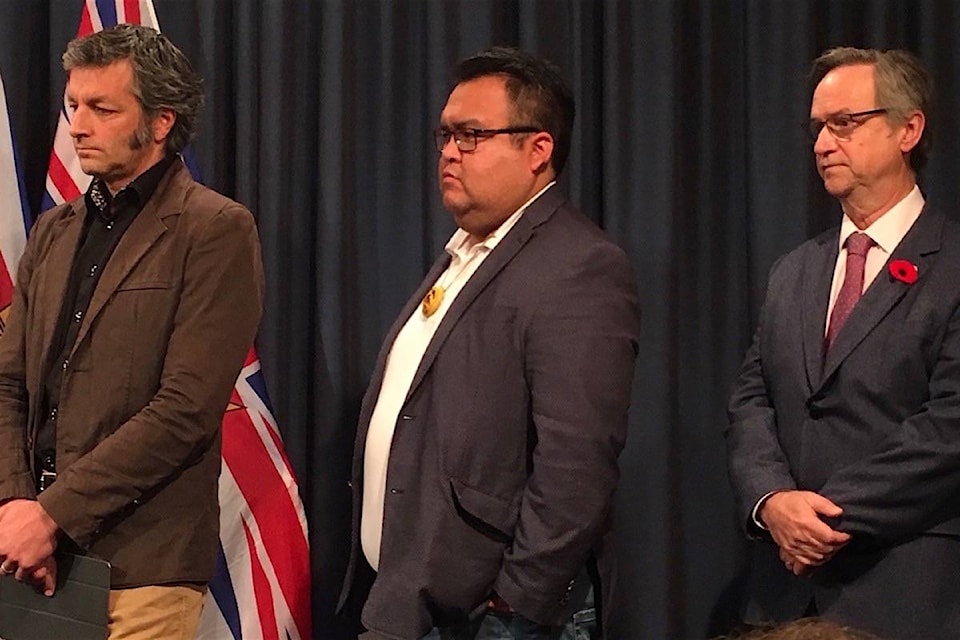Lessons from a rockslide in the Fraser River, flooding in Grand Forks and wildfire evacuations across the B.C. Interior are informing an overhaul of B.C. emergency management procedures.
Public Safety Minister Mike Farnworth announced a discussion paper and consultation Monday that will carry on until the end of January, with changes to the law governing evacuation orders and other emergency measures that affect communities and residents.
“Updating this legislation is long overdue,” Farnworth said Monday. “The Emergency Program Act was based on the War Measures Act, and it hasn’t been updated since 1993.”
Farnworth said B.C. approach will incorporate the “Sendai Framework,” a disaster response system named after the capital city of Myagi Prefecture in Japan. That region was devastated by a 2011 earthquake and tsunami, and the framework focuses mobilizing society to reduce disaster risk.
Protective dike construction in Myagi Prefecture, Japan I visited in 2016. The 2011 Fukushima quake and tsunami wiped out the fishing village here, a tragedy that produced the "Sendai Framework" named for Myagi's capital city. pic.twitter.com/zNMuCDOlzh
— Tom Fletcher (@tomfletcherbc) October 28, 2019
The Sendai Framework includes methods to “build back better,” to reduce future risks such as was done with flooding in High River, Alta. in 2013, Farnworth said.
RELATED: Grand Forks tackling debris left from flooding
RELATED: Fraser River landslide a race to save salmon
RELATED: Emergency study finds communication a big issue
Farnworth introduced the three-member panel that will to gather input and recommend changes. It includes former B.C. Liberal cabinet minister George Abbott, whose report on the lessons of the 2017 wildfire season identified the lack of coordination between the province and small, isolated communities. He also was tasked with speeding up applications to B.C.’s disaster recovery programs.
“If B.C. is going to better support communities and first nations from mitigation right through to recovery, there needs to be strong and inclusive legislation backing it, that’s what these changes have an opportunity to do,” Abbott said.
Another panel member is Roly Russell, chair of the Kootenay Boundary, who grappled with devastating flooding in Grand Forks the following year. He said the emergency response worked well, but “we had no playbook” for a recovery that is years in the making.
Kootenay-Boundary RD chair Roly Russell talks about need for disaster recovery plans #Bcleg #bcwildfire pic.twitter.com/QBEfUFgL1F
— Tom Fletcher (@tomfletcherbc) October 28, 2019
“It felt like a blank canvas when it came to designing a recovery plan and designing a recovery team,” Russell said. “A few references in provincial guidance material and part of a page in our regional plan seemed to be about the extent of recovery planning for an event of this magnitude.”
One of the issues was using workforce housing trailers to shelter people who were forced from their homes for long periods due to flooding. The trailers “wouldn’t meet the wellness needs of our community, would be expensive and create future problems,” Russell said.
The other panelist is Tsartlip Chief Don Tom, who said he will work to see Indigenous communities integrated more fully into the provincial response. That was a key finding of Abbott and Chapman’s 2017 report, which made more than 100 recommendations to government.
Tsartlip Chief Don Tom speaks about effect of #BigBarSlide on Indigenous communities #Bcleg #bcpoli pic.twitter.com/cfZTLnOia4
— Tom Fletcher (@tomfletcherbc) October 28, 2019
“The Big Bar landslide this year was a clear example of the type of emergencies we are likely to see more of in the future, and it caused significant losses to salmon runs on the Fraser River,” Tom said. “For first nations reliant on the salmon, it was an extremely challenging season, and we hope it’s an event that can be learned from moving forward.”
@tomfletcherbc
tfletcher@blackpress.ca
Like us on Facebook and follow us on Twitter.
